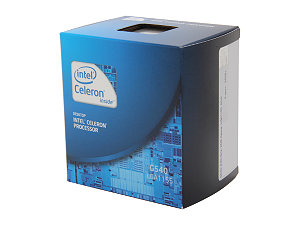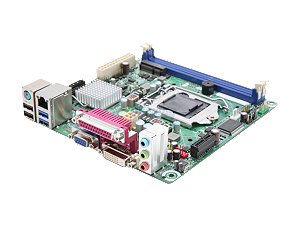Holiday 2012 Small Form Factor Buyer's Guide
by Zach Throckmorton on December 5, 2012 1:55 AM ESTSmall Size, Small Price Tag
While Intel has yet to release Ivy Bridge-based Celeron-class (i.e. cheap) CPUs, I briefly reviewed the Celeron G530's performance in a previous budget buyer's guide. Intel has, however, given its entry-level chips a modest speed bump in that the Celeron G540 and G550 models are often available for a dollar or two more than the G530. Because they are adequate for day-to-day tasks and are priced so low, they remain the kings of the budget CPUs.
 We've paired the Celeron G540 with one of the least expensive ITX Socket 1155 motherboards, Intel's BOXDH61DLB3. While there are less expensive boards, reliability issues prevent us from giving them the nod in this buyer's guide. Intel's entry-level ITX model offers basic features as well as USB 3.0 ports. Note that it does not have a PCIe x16 lane, instead offering a single PCIe x1 lane. This is likely not a concern for a budget, general office productivity box that will likely never need a video card installed but might need a wireless adapter card. Furthermore, its SATA ports are limited to SATA II speeds, so the newest SSDs that use SATA III will be crippled. Again, though, this is a budget system and something has to give. If you need a PCIe x16 lane and SATA III ports, you'll need to step up to a board like ASRock's B75M-ITX or ASUS' P8H77-I.
We've paired the Celeron G540 with one of the least expensive ITX Socket 1155 motherboards, Intel's BOXDH61DLB3. While there are less expensive boards, reliability issues prevent us from giving them the nod in this buyer's guide. Intel's entry-level ITX model offers basic features as well as USB 3.0 ports. Note that it does not have a PCIe x16 lane, instead offering a single PCIe x1 lane. This is likely not a concern for a budget, general office productivity box that will likely never need a video card installed but might need a wireless adapter card. Furthermore, its SATA ports are limited to SATA II speeds, so the newest SSDs that use SATA III will be crippled. Again, though, this is a budget system and something has to give. If you need a PCIe x16 lane and SATA III ports, you'll need to step up to a board like ASRock's B75M-ITX or ASUS' P8H77-I.
Housing the budget build is Apex's MI-008, a longtime favorite of mine for cheap ITX systems. It's reasonably well-constructed, and comes with a serviceable 250W power supply. Its thermals aren't particularly impressive, but for a system lacking a discrete graphics card and running a Sandy Bridge Celeron, it doesn't need to have the best airflow. The MI-008 can accommodate full size hard and optical drives, which helps keep costs down.
 As for the memory, a single 4GB stick of budget DDR3-1333MHz is sufficient for basic computing in Windows 7 64-bit (or Windows 8 if you want to go that route), and leaves an open slot so upgrading to 4GB in the future will be cheap and easy. Hard drive and solid state drive prices are especially dynamic this time of year, making recommendations difficult. While day to day hard drive prices remain elevated in the wake of the notorious Thailand floods, sale prices are beginning to get back to where they were before hard drive supplies were disrupted late last year. If you're patient and pay attention to prices, you will likely be able to snag a mainstream 7200RPM 1TB hard drive for $60 or less. If you don't need much local storage, a 64GB SSD will give you an enormous performance boost for about the same price.
As for the memory, a single 4GB stick of budget DDR3-1333MHz is sufficient for basic computing in Windows 7 64-bit (or Windows 8 if you want to go that route), and leaves an open slot so upgrading to 4GB in the future will be cheap and easy. Hard drive and solid state drive prices are especially dynamic this time of year, making recommendations difficult. While day to day hard drive prices remain elevated in the wake of the notorious Thailand floods, sale prices are beginning to get back to where they were before hard drive supplies were disrupted late last year. If you're patient and pay attention to prices, you will likely be able to snag a mainstream 7200RPM 1TB hard drive for $60 or less. If you don't need much local storage, a 64GB SSD will give you an enormous performance boost for about the same price.
While Windows 7 64-bit remains the de facto standard operating system for PCs, note that Windows 8 64-bit is now also available. Note that for this budget build, the $92 Windows license accounts for about 25% of the total cost. If you're on an extremely tight budget, or simply want to explore other operating systems, be sure to check out a free OS like Ubuntu.
| Component | Product | Price |
| Case | Apex MI-008 | $48 |
| Power supply | (included with case) | |
| CPU | Intel Celeron G540 2.5GHz dual-core | $45 |
| Motherboard | Intel BOXDH61DLB3 mITX | $72 |
| RAM | G.Skill Value 4GB DDR3-1333MHz | $18 |
| Hard drive | Seagate Barracuda 1TB ST1000DM003 | $70 |
| SSD alternate | Intel 330 Series 60GB | $70 |
| Optical drive | Samsung SH-224BB DVD burner | $16 |
| Operating system | Windows 7 64-bit Home Premium OEM | $92 |
| Total: | $361 |
Check the next page for our small form factor file server build.










74 Comments
View All Comments
Taft12 - Wednesday, December 5, 2012 - link
A 40mm fan? No, no, no, no and no.DanNeely - Wednesday, December 5, 2012 - link
It's a 17W mobile part. A slow 40mm fan is more than sufficient when combined with the improved airflow of even a SFF case when compared to a laptop chassis. The similar sized fan on my 18W E-350 file server has never gotten gotten loud enough to be heard.dananski - Wednesday, December 5, 2012 - link
He's probably concerned about the pitch of the sound. I've avoided anything smaller than a 120mm fan in all my builds as even quiet high pitched noise is a nuissance. Your file server probably has a low CPU load compared to the video playback cyrusfox intends to do, so I'd expect it to stay nice and cool with the fan barely on. He might not be so lucky.As for the board & integrated CPU, seems pretty good value for money, though I'd like to see some more powerful mobile chips in this sort of design. Will probably become more common with Haswell.
cyrusfox - Thursday, December 6, 2012 - link
Board came today, I am load testing it currently. Bios is nice, fan is fully customizable(so much so that you can set it low enough to not turn on) and cpu and gpu power can be altered(step down, you can also underclock the cpu or diable a core-won't be doing that). Trying to see how low it can go and be stable. So far it is silent and not even in its case yet(cardboard build, waiting for the last parts to arrive).You don't need much air flow for a tiny 17watt chip. The fan is removable, so you could just add some heat pipes and make a passive build out of it, CPU good to 100°C. It really is a low profile board, highest part is the audio connector on IO. Whenever Temash gets out, I'll probably replace it, but this should be more than good enough to emulate, stream, and surf on the couch.
ricardoduarte - Wednesday, December 5, 2012 - link
Why are you suggesting 1TB hd, and no SSD in the gaming systems.I would one of these would be better:
-2TB hd, and 256gb ssd would be a better choice.
or
- 3TB hd and 64gb ssd for cache
Norseman4 - Wednesday, December 5, 2012 - link
True it's double the price of the OS, but it looks like Win8's Storage Spaces revives and possibly improves the best part of the original WHS ... Drive Extender.It's be nice to see an investigation into SS and it's direct comparison to DE, though. (I've only seen pages on how to set up a SS, so how it functions is still unknown to me)
DanNeely - Wednesday, December 5, 2012 - link
I looked at W8 + Storage Spaces recently; but benches put it significantly slower than rival fakeraid options. Hopefully MS will be able to patch it up to more competitive levels in an upcoming service pack (Blue?) or W9.bigfire - Wednesday, December 5, 2012 - link
I've had my AMD Athlon 64 X2 for about 6 years and it still works well. I've never had any troubles with this guy.DanNeely - Wednesday, December 5, 2012 - link
What mobo chipset did you use? Both of mine have been dead for over a year after nForce4 boards 4 and 5 followed my first 3 into the grave.amdwilliam1985 - Wednesday, December 5, 2012 - link
Same here, I have x2 2.5ghz with stock fan, it's probably been 5 years now.It's still running as a champ for my workload. The only upgrade I'm made in the past 2 years is the $99 5770 :) great investments.